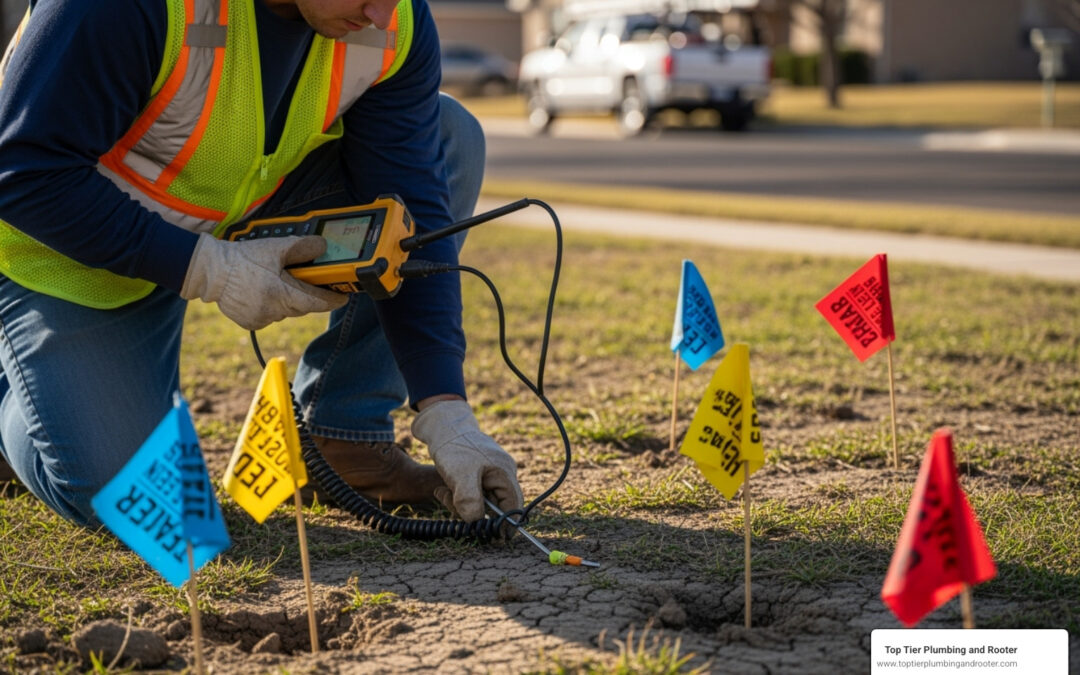Why Gas Line Detection Could Save Your Life
Gas line detection is the process of accurately locating buried natural gas and propane lines before any excavation or construction begins. Here’s what you need to know:
Key Detection Methods:
- Electromagnetic (EM) locating – Works on metallic pipes using signal transmission
- Ground Penetrating Radar (GPR) – Detects all pipe types through radar reflections
- Acoustic methods – Uses sound injection for plastic pipes without tracer wire
- Call 811 – Free public utility marking service (covers only utility-owned lines)
Warning Signs of Gas Leaks:
- Rotten egg or sulfur smell
- Hissing sounds near gas lines
- Dead vegetation in unusual patterns
- Bubbling in standing water
Gas lines account for about 40% of all buried utility damages in the U.S. each year. A single strike can cause explosions, fires, evacuations, and even death. The difference between a successful project and a catastrophic accident often comes down to one simple step: knowing exactly where those invisible gas lines are buried.
Most homeowners don’t realize they’re responsible for locating private gas lines – those running from their meter to outdoor grills, pool heaters, or detached buildings. While 811 marks public utilities for free, private lines require professional detection services.
The good news? Modern detection technology can pinpoint gas lines within 6 inches of their actual location. But only if you use it before you dig.
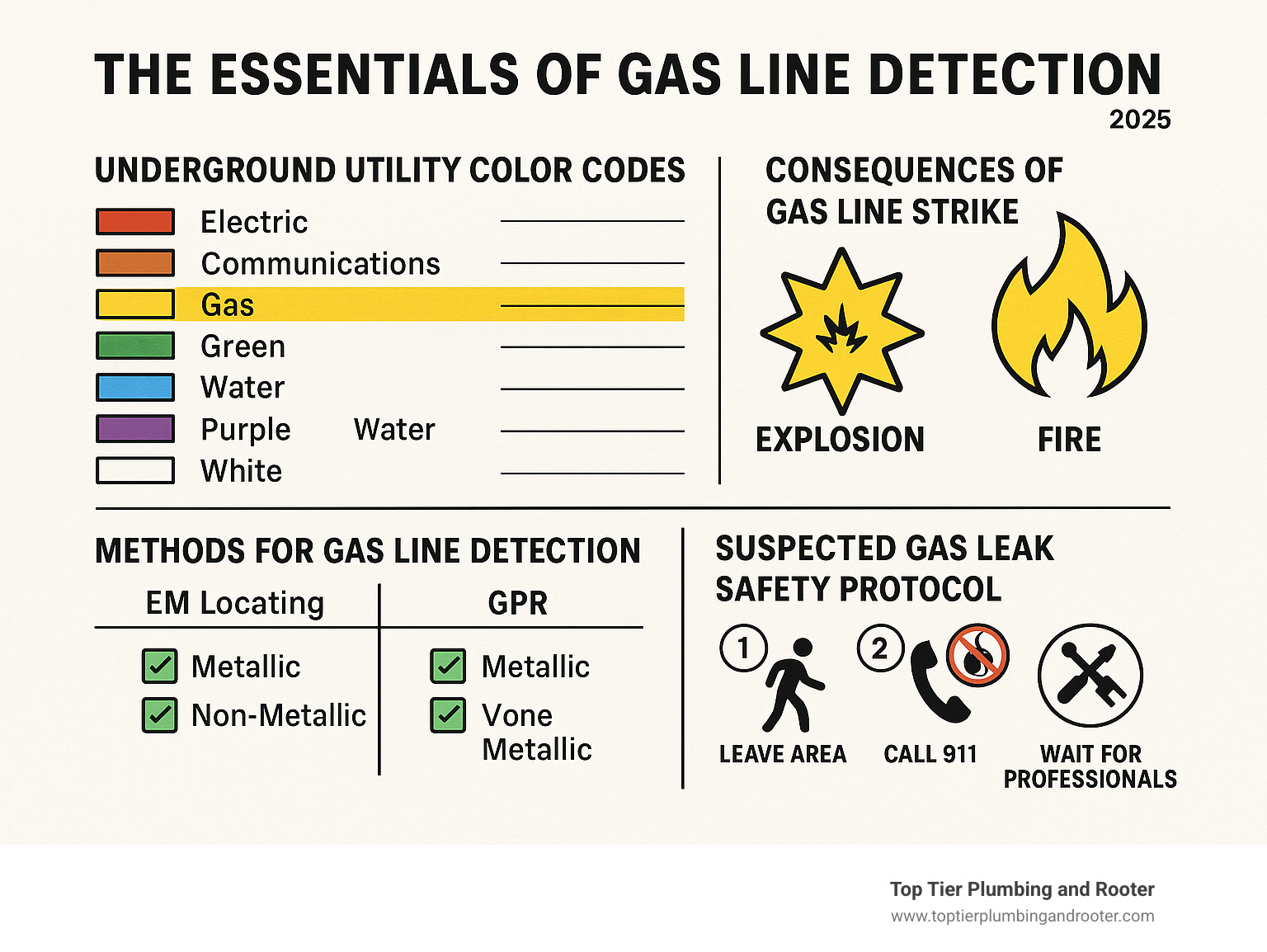
Why Accurate Gas Line Detection is Critical
When you’re ready to install a new deck or plant a garden, an invisible network of gas lines lies beneath your feet. Gas line detection isn’t just a precaution—it’s essential for protecting your family and property.
Striking a buried gas line can be catastrophic. A small nick can release flammable gas, leading to explosions that can level buildings, rapidly spreading fires, and immediate neighborhood evacuations.
Beyond the immediate danger, strikes cause service outages, leaving homes without heat or cooking gas. The responsible party faces hefty fines and repair costs, and the project grinds to a halt with costly delays.
Public safety is the primary concern. Accurate gas line detection before digging is a critical step that protects everyone. Understanding these risks helps you make informed decisions. For more insight into emergency situations, check out The Dangers of a Gas Leak and What You Can Do in an Emergency.
The Most Common Causes of Gas Line Damage
Most gas line accidents are avoidable. The biggest culprits are unmarked lines due to inaccurate or outdated utility records, which leave dangerous gaps in your knowledge.
Many people go wrong by skipping the crucial step of calling 811. This failure to call 811 is responsible for countless preventable accidents. Even with marked lines, improper excavation techniques, like digging outside marked areas, can cause damage.
A risky assumption is thinking you know pipe depth. A line’s depth can vary dramatically across a property due to soil settling, grading changes, or past installation differences.
What to Do if You Suspect a Gas Leak
Your nose is the best early warning system. Gas companies add a chemical creating the unmistakable “rotten egg” smell to grab your attention. Trust that scent; it could save your life.
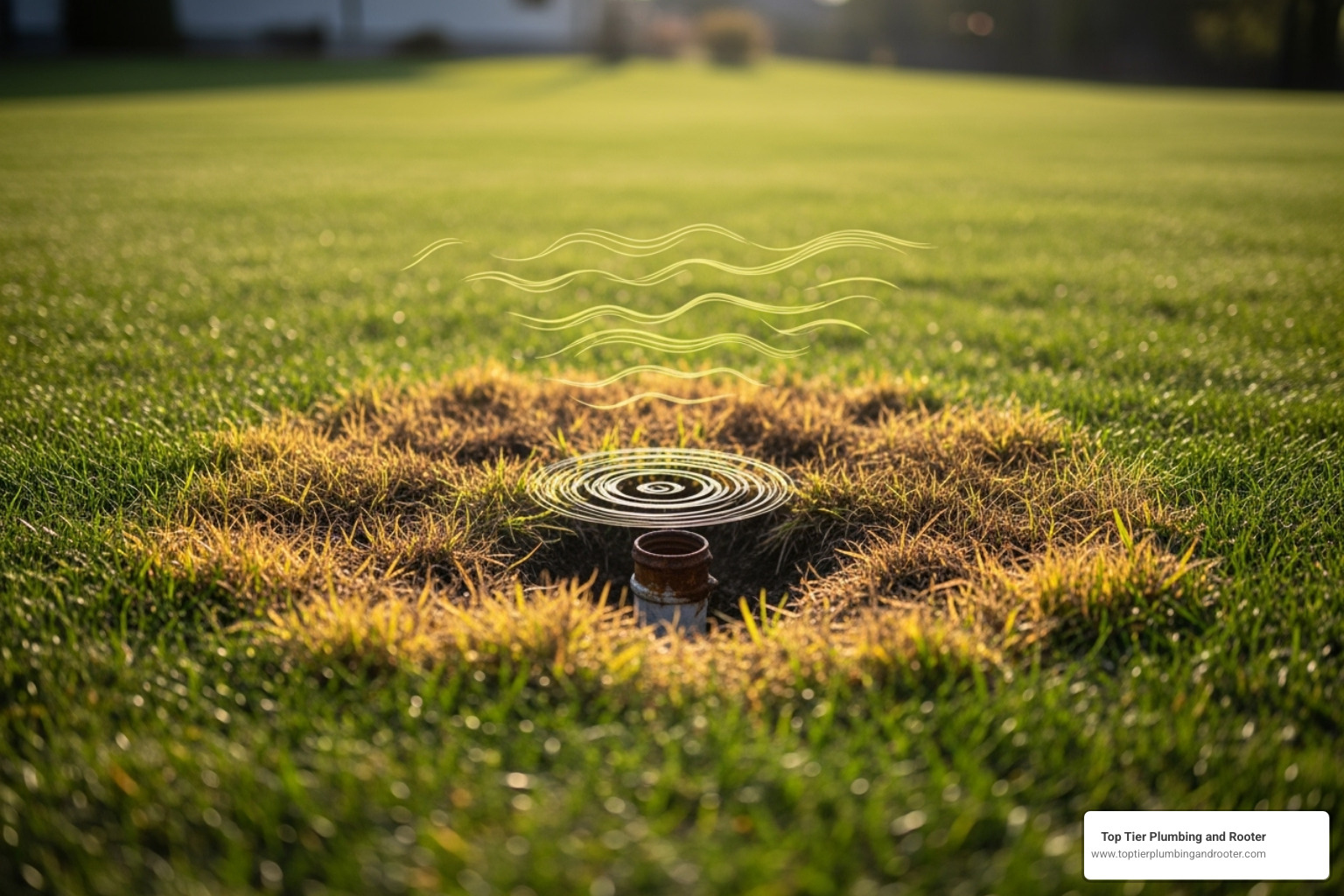
Listen for hissing sounds near gas appliances or meter areas. Outside, watch for bubbling in wet ground or standing water, which happens when gas bubbles up through soil. You might also notice dead vegetation in unusual patterns, since escaping gas can kill plants.
If you detect any warning signs, respond immediately. Evacuate everyone without stopping for belongings. Avoid using electronics or light switches that could create a spark. Once at a safe distance (at least 350 feet away), call 911 and your gas utility company.
Gas leaks are serious emergencies that require professional handling. Never attempt repairs yourself. For comprehensive guidance on gas emergency procedures, visit our detailed resource: What to Do When You Smell Gas: A Homeowner’s Guide to Safety.
Public vs. Private: Understanding Your Responsibility for Gas Line Detection
A fact that surprises many homeowners is that responsibility for gas lines is divided. Your gas meter is the dividing line that determines who is responsible for locating which pipes.
Everything leading up to your meter is the utility company’s territory. These are the public mains that deliver gas from the street to your home. The utility company owns, maintains, and is responsible for locating them.
Everything beyond your meter is your responsibility. These private service lines—running to an outdoor kitchen, pool heater, or detached garage—are yours to maintain and locate. This distinction is critical for gas line detection.
The 811 “Call Before You Dig” Process
The slogan “Call Before You Dig” refers to the 811 service, your first line of defense against striking buried utilities. This free, nationwide service is required by law in most places before any digging. You can learn more at the official Call 811 website.
When you dial 811, your request is routed to local utility companies, who send locators to mark their public utility lines with colorful flags and spray paint. Gas lines are marked in yellow, water in blue, and electric in red.
The catch is that 811 only covers utility-owned, public lines. The gas line running from your meter to a backyard fire pit, for example, is a private line and will not be marked by this service.
Just as you wouldn’t expect an outsider to know your home’s plumbing quirks (which is why we recommend inspections, as detailed in Why Plumbing Inspections Are Essential Before Buying a Home), you can’t expect 811 to know about your private lines.
When You Need a Private Locator
So when do you need to call in the professionals for gas line detection? Anytime you plan to dig near potential private gas lines.
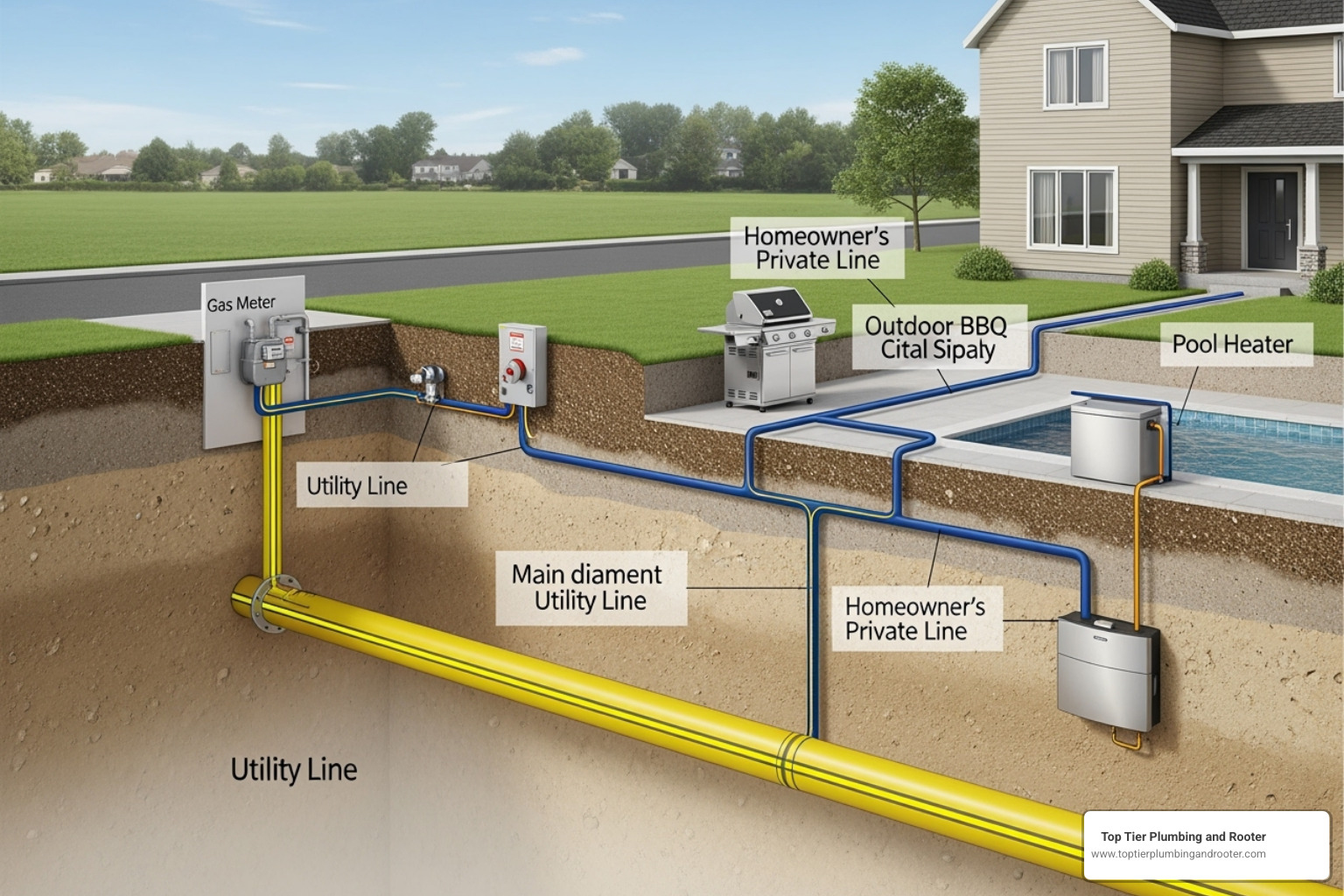
Gas lines to outdoor kitchens, pool heaters, and detached garages, workshops, or fire pits all typically have their own underground gas supplies.
Private lines are tricky because they are often installed by various contractors, and records can be incomplete or wrong. We’ve seen lines buried just inches below the surface when records indicated a depth of three feet. In congested utility corridors, where multiple lines are crammed together, specialized equipment is essential for accurate locating.
Inaccurate public records are more common than you’d think. Your beautiful landscaping plan might be right on top of a gas line that never made it onto an official map.
This is why professional gas line detection services from Top Tier Plumbing and Rooter exist. We have the specialized equipment and expertise to accurately locate these private lines throughout Riverside and San Bernardino counties. We understand that your safety isn’t worth gambling on, and we’re here to make sure your project gets done right and safely.
Professional Gas Line Locating Methods Explained
Finding buried gas lines is a science requiring the right tools. Professional gas line detection uses sophisticated technology to locate hidden pipes, with each method suited for different situations. Different methods work better for metal or plastic pipes, and some can spot what others miss. Here’s how the two main approaches stack up:
| Factor | Electromagnetic (EM) Locating | Ground Penetrating Radar (GPR) |
|---|---|---|
| Pipe Material | Metallic pipes (steel, copper, cast iron); Plastic pipes with tracer wire | All pipe types (metallic, plastic, concrete, clay); Also detects non-pipe features like voids, soil disturbance |
| Soil Conditions | Works well in most soil types; Can be affected by highly conductive soils or high electromagnetic interference | Performance varies with soil; Best in sandy, dry, uniform soils; Challenged by high clay content, saturated soils, or highly conductive soils |
| Accuracy | High positional accuracy for conductive pipes (within inches); Depth accuracy can vary | High positional accuracy (within 6 inches to center of utility); Depth accuracy +/- 10-15% |
| Best Use Cases | Tracing known metallic lines; Locating tracer wires on plastic pipes; Identifying specific utilities with direct connection | Comprehensive site scans; Locating non-metallic pipes; Mapping complex utility networks; Detecting unknown objects and trench lines |
Electromagnetic (EM) Locating for Metallic Pipes
Electromagnetic (EM) locating is a highly effective method for metallic gas pipes and forms the backbone of professional gas line detection. A transmitter sends an electromagnetic signal along the metal pipe. A handheld receiver above ground detects the signal’s field, translating it into a precise location and estimated depth.
Active locating directly applies a signal for clear tracking. Passive locating detects existing electromagnetic fields but is less precise for specific gas lines.
EM locating excels with conductive pipes, providing a clear, reliable signal. It’s also the go-to method for plastic pipes that have a tracer wire system, which creates a continuous path for the signal. However, EM locating can be affected by interference from other nearby utilities. And remember, if our detection work reveals any concerns, prompt attention is critical for Gas Leak Repairs.
Ground Penetrating Radar (GPR) for All Pipe Types
Ground Penetrating Radar (GPR) offers a different approach to gas line detection, capable of seeing both metallic and non-metallic pipes.
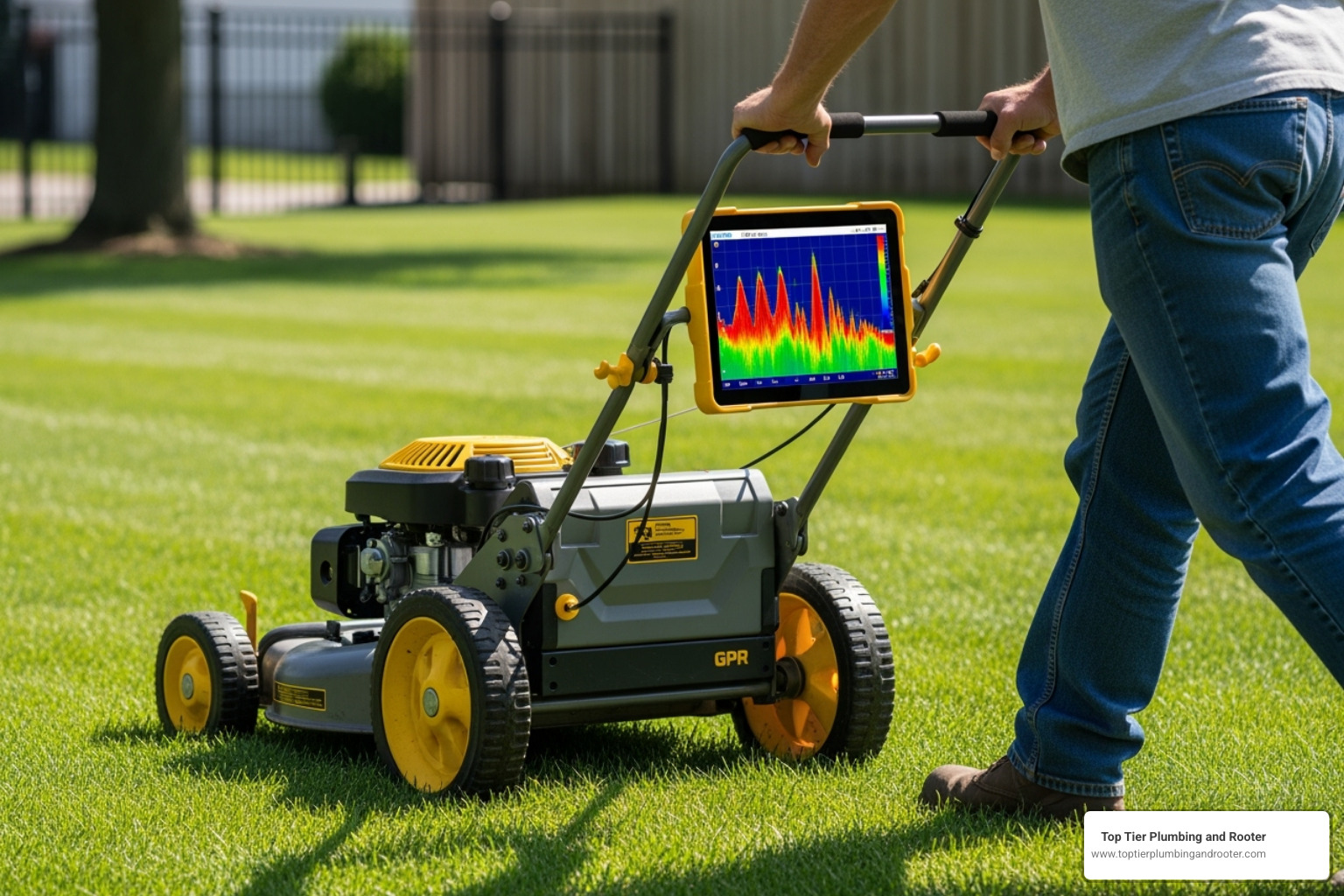
GPR sends high-frequency radio waves into the ground. When the waves hit a buried object like a pipe or disturbed soil, they reflect to an antenna. The GPR unit displays these reflections as hyperbolic curves, which trained technicians interpret to map buried utilities.
GPR is valuable for detecting plastic gas lines without tracer wire, which are invisible to EM methods. It can also spot the disturbed soil from the original trench, helping to confirm a line’s path. In terms of accuracy, GPR typically gets us within 6 inches of the utility’s center, with depth readings accurate to within 10-15%.
GPR performance depends on soil conditions. It works best in sandy, dry soils and is challenged by high clay content or saturated ground, which can absorb the radar waves and limit detection depth and clarity.
Advanced Methods for Plastic Pipe Gas Line Detection
Plastic pipes are a unique challenge for gas line detection because they don’t conduct electricity, making them invisible to standard EM locators unless a tracer wire is present. This is why installing tracer wire is now standard practice for new plastic gas lines. But for older lines or those with broken tracer wires, advanced methods are needed.
Acoustic locating finds these lines by injecting sound waves into the gas line, causing vibrations that are detected by sensitive ground sensors. The technology works across a range of pressures and can filter out background noise.
Sondes, small transmitters inserted into pipes, can be tracked from the surface with EM receivers for pinpoint locating.
Marker balls are passive electronic markers buried with the utility that can be detected years later. Detectable warning tape with an aluminum core can also be buried above lines and found with a metal detector.
The bottom line is that installing tracer wire on new plastic gas lines is essential for ensuring they can be located for decades to come, paying huge dividends in safety.
From Marks on the Ground to Safe Excavation
After professional gas line detection, your yard will be covered in colorful flags and paint. These marks are a critical communication system designed to keep you safe.
The nationwide APWA Uniform Color Code is used. Yellow is the warning color for gas, oil, or steam. Red marks electrical lines, blue is for water, and green indicates sewer lines. These colors represent potentially dangerous utilities.
These marks show the approximate horizontal position of buried lines. While horizontal location is very accurate, depth estimation is less reliable due to factors like soil conditions and pipe settling. That’s why professional experience is so important, a point we cover in The Hidden Dangers of DIY Plumbing: Why You Should Hire a Professional.
The Tolerance Zone and Safe Digging Practices
The tolerance zone is a critical safety buffer, typically the width of the utility plus 18 inches on each side. No mechanized equipment like excavators or trenchers should be used within this zone.
Within this zone, you must use hand digging with non-powered tools like shovels. It’s slower but essential for safety.
Soft digging (or vacuum excavation/potholing) is an even safer method. It uses pressurized water or air to loosen soil, which is then vacuumed away. Potholing allows you to see the exact location, depth, and material of the line without risk of damage.
Visual verification through potholing is your ultimate insurance policy, confirming that what was marked matches what’s in the ground.
For handling other unexpected situations around your home, check out Emergency Plumbing 101: How to Handle Plumbing Issues Before Help Arrives.
What to Do if You Strike a Gas Line
Even with precautions, accidents happen. If you damage a gas line, every second counts. Here’s your emergency action plan:
- Evacuate everyone immediately – Get all people and pets away from the area and upwind.
- Call 911 and the utility company from a safe distance – Do not use your phone near the leak site.
- Do not attempt to repair it yourself – Gas line repairs require qualified professionals.
- Eliminate all ignition sources – Turn off vehicles, extinguish flames, and avoid anything that could spark.
Your first instinct might be to fix the problem, especially if the damage seems minor. Don’t. Gas leaks can escalate into a catastrophic explosion in seconds. Professional gas technicians have the tools and training to make repairs safely. Your safety matters more than any project timeline.
Frequently Asked Questions about Gas Line Detection
When planning an excavation project, many homeowners have questions about gas line detection. Here are answers to the most common ones we hear in Riverside and San Bernardino counties.
How accurate are gas line locates?
The accuracy of gas line detection depends on several factors, but modern technology is quite precise.
Horizontally, professional locating is very accurate. GPR is typically accurate to within 6 inches of the utility’s center, and when combined with EM methods on metal lines, the results usually agree within 4-6 inches.
Depth estimation is less precise, typically accurate to within +/- 10-15% of the actual depth. For a line estimated at 3 feet deep, the actual depth is likely between 2.5 and 3.5 feet.
Accuracy can be affected by soil conditions and utility congestion. This is why we often recommend visual verification through careful hand digging for critical projects.
What do the different colored flags in my yard mean?
The colored flags in your yard follow the APWA Uniform Color Code, a nationwide system for marking underground utilities.
- Yellow flags mark gas, oil, steam, and other petroleum products.
- Red flags warn about electric power lines and cables.
- Blue marks show potable water lines.
- Green indicates sewers and drain lines.
- Orange flags mark communication lines like internet and phone cables.
- You might also see purple for irrigation systems, pink for temporary survey marks, and white for proposed excavation boundaries.
These aren’t just suggestions—they’re critical safety warnings.
How long is a utility locate valid for?
Utility locates are not valid forever. Most states have validity periods of 14 to 30 days, though this varies by location.
The short window exists because ground conditions change. Rain can shift soil, and markings can be disturbed or fade. If your project is delayed beyond the validity period, you must call for a re-mark before digging.
Our advice is to preserve the markings as much as possible. If you have any doubts, call for fresh marks. It’s a small step that prevents major headaches and keeps everyone safe.
Gas line detection isn’t just about avoiding repair costs; it’s about protecting your family and community. When you have questions, don’t hesitate to ask the professionals who do this work every day.
Your Safety is Our Top Priority
Throughout this guide, we’ve walked you through the critical importance of gas line detection – and for good reason. What starts as an innocent weekend project or home improvement can quickly turn dangerous without proper preparation. The consequences of striking a buried gas line extend far beyond project delays; they can result in explosions, fires, evacuations, and even loss of life.
Think of gas line detection as your safety net. It’s the invisible shield that protects you, your family, and your neighbors from the hidden dangers lurking beneath your property. We’ve covered the essential steps: calling 811 for public utilities, understanding that private lines beyond your meter are your responsibility, and recognizing when professional detection services become necessary.
The reality is that modern detection technology – whether it’s electromagnetic locating for metallic pipes or ground penetrating radar for all pipe types – can pinpoint gas lines with remarkable accuracy. But this technology only works when you use it before you break ground.
Your gas meter serves as the dividing line between public and private responsibility. While 811 handles the public side beautifully, those private lines running to your outdoor kitchen, pool heater, or detached garage need professional attention. That’s where safe digging practices within the tolerance zone, hand digging, and visual verification through potholing become your best friends.
At Top Tier Plumbing and Rooter, we’ve seen too many close calls and unfortunate accidents that could have been prevented with proper gas line detection. Whether you’re planning a simple garden bed or a major construction project in Riverside and San Bernardino counties, we’re here to ensure you dig smart and stay safe.
For expert assistance with Plumbing and Gas Repairs in Riverside and San Bernardino Counties, trust the licensed professionals at Top Tier Plumbing and Rooter to ensure your project is done safely and correctly. Because when it comes to gas lines, there’s no such thing as being too careful.


